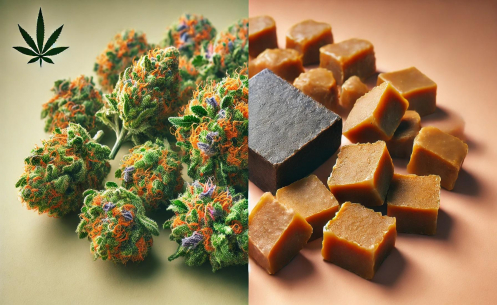If you have ever walked into a coffee shop, you have probably heard the terms "weed" and "hash" mentioned. Although both come from the cannabis plant, there are some key differences between these two products. But what exactly are those differences, and why would you choose one over the other? Let's delve deeper into the difference between weed and hash, so you better understand what you might be putting in your joint or vaporizer!
What are weed and hash?

Weed, also known as marijuana, comes from the flowers of the female cannabis plant. These flowers are dried and then smoked, vaporized, or made into edible products. Weed is the most well-known form of cannabis and is known for its strong scent and resinous buds.
Hash, on the other hand, is made from the resin (trichomes) of the cannabis plant. This resin is collected, pressed, and often heated to form a compact block or ball. The result is a more concentrated form of cannabis that is often stronger than weed.
How are weed and hash made?

The production process of weed and hash differs significantly. Let's look at both methods:
- Weed: Weed is obtained by harvesting the flowers of the cannabis plant, drying them, and then curing them (a process of slowly drying and storing to improve flavor and potency).
- Hash: Hash is made by collecting the trichomes of the cannabis plant. Trichomes are the small, sticky resin glands on the buds and leaves of the plant that contain THC and other cannabinoids. This resin is sifted, collected, and then pressed into a solid substance.
Appearance and texture

Weed and hash differ not only in their production process but also in their appearance:
- Weed: Weed looks like dried flowers with many small hairs (trichomes). The buds are often green with various hues, such as orange or purple.
- Hash: Hash has a very different appearance from weed. It is usually brown or black and comes in the form of blocks, balls, or sometimes as a sticky paste.
THC and CBD concentrations
One of the main differences between weed and hashish is the THC and CBD content. THC is the substance responsible for the psychoactive effect of cannabis, while CBD is known for its calming properties.
- Weed: Weed can vary in THC and CBD content, depending on the strain. Some strains have a higher THC content, while others contain more CBD. This depends on the genetics of the plant.
- Hashish: Because hashish is a concentrated form of cannabis, it typically contains a higher THC content than weed. This means that you often need less to achieve the same effect.
Check out our full range of Weed Seeds here!
Consumption methods

Cannabis and hashish are consumed in different ways, although there is also overlap. Here are some common methods:
- Cannabis: Cannabis is usually smoked in a joint, pipe, or bong, but can also be vaporized or made into edible products like space cake.
- Hashish: Hashish is often mixed with tobacco and smoked in a joint. It can also be heated and vaporized in a special vaporizer, or even made into hash oil.
Effects of cannabis versus hashish

The effects of cannabis and hashish can vary, depending on THC and CBD content, but also on how it is consumed:
- Cannabis: Cannabis is known for its euphoric and sometimes relaxing effects. Depending on the strain, you may feel energetic or sleepy.
- Hashish: Because hashish is more concentrated, the effects can be stronger and last longer than with cannabis. Many users report a deeper, more physical effect from hashish.
Flavors and aromas

Another interesting difference between cannabis and hashish is the taste and smell. Both products have a unique scent profile, but they can vary widely:
- Cannabis: The smell of cannabis is often sharp and spicy, with different tones depending on the strain. Some strains can smell sweet, citrusy, or even earthy.
- Hashish: Hashish often has a deeper, richer aroma that is more earthy or spicy compared to cannabis. The taste can also be somewhat milder due to the concentration process.
Use in different cultures

Another difference between weed and hash is the price. The price can vary depending on where you are and the quality of the product:
- Weed: In many countries, weed is more readily available, and the price can vary depending on the potency and rarity of the strain.
- Hash: Hash can sometimes be more expensive than weed, especially if it is of high quality or imported from countries with a rich tradition in hash production.
Conclusion
Whether you prefer weed or hash, both products offer unique experiences and flavors. Weed may be better suited for those who want to experience the pure flower of the cannabis plant, while hash is ideal for those looking for a more concentrated effect. Ultimately, the choice depends on your personal preference and the experience you seek. Just know that the difference between weed and hash lies not only in the effects but also in the production process, concentration, and method of use.



